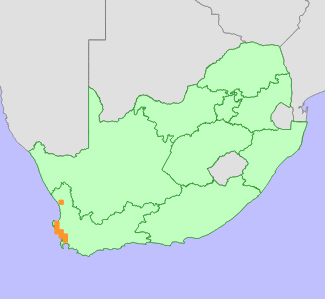|
Scientific Name | Ruschia indecora (L.Bolus) Schwantes |
Higher Classification | Dicotyledons |
Family | AIZOACEAE |
Synonyms | Mesembryanthemum indecorum L.Bolus |
Common Names | Koeberg Tentfig (e) |
National Status |
Status and Criteria | Near Threatened B1ab(ii,iii,iv,v) |
Assessment Date | 2016/01/13 |
Assessor(s) | C. Klak, D. Raimondo, N.A. Helme & L. von Staden |
Justification | A widespread and formerly common species that is becoming increasingly rare due to ongoing habitat loss and degradation. At present, it is known to remain at 12 locations, and its EOO is 4456 km². It is near to the thresholds for the category Vulnerable, and if current trends in habitat loss is to continue, it is likely to become in danger of extinction in the near future. |
Distribution |
Endemism | South African endemic |
Provincial distribution | Western Cape |
Range | Olifants River to Bloubergstrand. |
Habitat and Ecology |
Major system | Terrestrial |
Major habitats | Namaqualand Strandveld, Cape Flats Dune Strandveld, Langebaan Dune Strandveld, Saldanha Flats Strandveld, Cape Flats Sand Fynbos, Atlantis Sand Fynbos, Hopefield Sand Fynbos |
Description | Coastal lowland fynbos in deep sands. |
Threats |
| This species has already lost more than 80% of its habitat in the southern part of its range to urban and agricultural expansion. It continues to decline due to ongoing habitat loss to urban and industrial development. Remaining habitat fragments are densely infested with unmanaged alien invasive plants, which are outcompeting native species. Coastal development is causing ongoing decline of subpopulations between Velddrif and Melkbosstrand. In strandveld near the mouth of the Olifants River an isolated subpopulation is likely to be partially lost to crop cultivation. |
Population |
Recent field observations have significantly extended the known range of this species, and also indicate that it is still fairly common, in spite of extensive habitat loss and fragmentation. It is now known to remain at at least 12 locations, and field observations indicate that although the population has been fragmented, subpopulations are large.
|
Population trend | Decreasing |
Assessment History |
Taxon assessed |
Status and Criteria |
Citation/Red List version | | Ruschia indecora (L.Bolus) Schwantes | NT B1ab(ii,iii,iv,v) | 2017.1 | | Ruschia indecora (L.Bolus) Schwantes | EN B1ab(ii,iii,iv,v) | Raimondo et al. (2009) | |
Bibliography |
Goldblatt, P. and Manning, J.C. 2000. Cape Plants: A conspectus of the Cape Flora of South Africa. Strelitzia 9. National Botanical Institute, Cape Town.
Manning, J.C. and Goldblatt, P. 2012. Plants of the Greater Cape Floristic Region 1: The Core Cape Flora. Strelitzia 29. South African National Biodiversity Institute, Pretoria.
Raimondo, D., von Staden, L., Foden, W., Victor, J.E., Helme, N.A., Turner, R.C., Kamundi, D.A. and Manyama, P.A. 2009. Red List of South African Plants. Strelitzia 25. South African National Biodiversity Institute, Pretoria.
|
Citation |
| Klak, C., Raimondo, D., Helme, N.A. & von Staden, L. 2016. Ruschia indecora (L.Bolus) Schwantes. National Assessment: Red List of South African Plants version 2024.1. Accessed on 2025/11/08 |
 Comment on this assessment
Comment on this assessment


